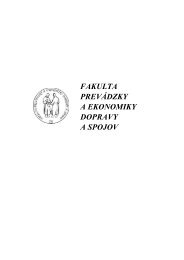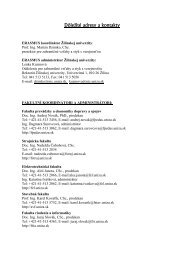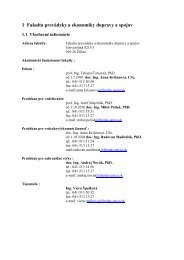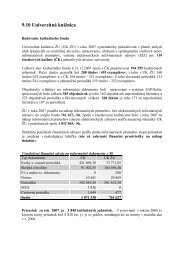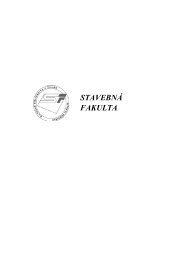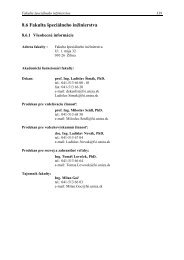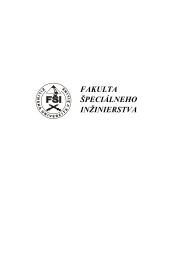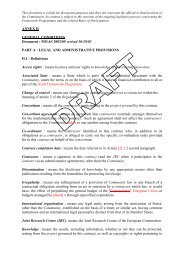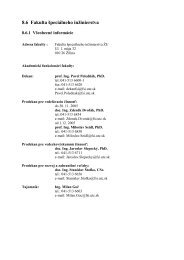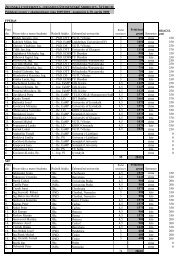posudzovanie vplyvu automobilovej dopravy na - Žilinská univerzita
posudzovanie vplyvu automobilovej dopravy na - Žilinská univerzita
posudzovanie vplyvu automobilovej dopravy na - Žilinská univerzita
You also want an ePaper? Increase the reach of your titles
YUMPU automatically turns print PDFs into web optimized ePapers that Google loves.
C O M M U N I C A T I O N S<br />
I S<br />
Roman Marcinkowski *<br />
POSUDZOVANIE KVALITY ČASOVÝCH PLÁNOV STAVIEB<br />
QUALITY ASSESSMENT OF CONSTRUCTION SCHEDULES<br />
Príprava časových plánov je tvorivá činnosť. Podľa predstavivosti a vy<strong>na</strong>liezavosti rôznych riešiteľov sa môžu vytvoriť rôzne verzie plánov<br />
rov<strong>na</strong>kého projektu. Potom je potrebné sa pýtať, ktorý plán je <strong>na</strong>jlepší, s ktorým scenárom vyko<strong>na</strong>nia prác je účinok prác <strong>na</strong>vrhnutých riešiteľov<br />
<strong>na</strong>jvýhodnejší. Tento článok uvádza formalizovanú metódu posudzovania kvality <strong>na</strong>vrhnutých časových plánov. Jej metodický základ je založený<br />
<strong>na</strong> modeli procesu plánovania výroby v stavebnej výkonnej jednotke. Posúdenie plánu je vztiahnutie <strong>na</strong> absolútnu stupnicu (v intervale 0,1)<br />
a je objektivizované s využitím nákladov <strong>na</strong> stredné straty pri realizácii.<br />
Preparing a schedule is a creative activity. Depending on the planner’s imagi<strong>na</strong>tion and inventiveness different visions of the plan of the<br />
same project are created. At this stage it is worth asking which plan is the best, with which sce<strong>na</strong>rio for the works execution the effect of the<br />
contractor’s construction operation is the most desirable. This article presents a formalized method of construction schedules’ quality assessment.<br />
Its methodical basis is constituted by the model of production scheduling process in a construction execution unit. The assessment of<br />
schedules is referred to the absolute scale (in interval 0,1) and is objectified using the costs of realization means outage.<br />
1. Introduction<br />
Schedule is a tool of material and time planning. In present<br />
times, in construction production planning, a computer with selected<br />
software for planning and controlling the project execution is<br />
used to prepare schedules. It allows constant updating of the vision<br />
of the operations, monitoring the progress of works, the engagement<br />
of resources, and an assessment of the effects.<br />
Computer planning technique e<strong>na</strong>bles experimenting on<br />
models. The set of tasks defined by the organizer – planner can<br />
be modified in many different ways, thus generating different sce<strong>na</strong>rios<br />
for the operations. Preparing a schedule is a creative activity.<br />
Depending on the planner’s imagi<strong>na</strong>tion and inventiveness different<br />
visions of the plan of the same project are created. At this<br />
stage it is worth asking which plan is the best, with which sce<strong>na</strong>rio<br />
for the works execution the effect of the contractor’s construction<br />
operation is the most desirable. The answer to this question poses<br />
certain difficulties. Production schedules, and project schedules<br />
can be assessed using different criteria [l]. The criteria are a set of<br />
preferences, whose parts are most often mutually contradictory.<br />
In this case it is necessary to combine the criteria using usability<br />
functions or employing the technique of reaching compromise<br />
evaluations.<br />
It must be stated that in the case of real production programs<br />
of construction execution units it is not possible to create optimal<br />
schedules in the exact meaning of the word. However, for each<br />
prepared production schedule it is possible to devise characteristics<br />
e<strong>na</strong>bling its value assessment. In order to compare a few schedules<br />
a synthetic assessment index is required, which is always disputable<br />
because it is defined on the basis of partial characteristics.<br />
This article will present a formalized method of construction<br />
schedules’ quality assessment. Its methodical basis is constituted<br />
by the model of production scheduling process in a construction<br />
execution unit. The assessment of schedules is referred to the<br />
absolute scale (in interval 0,1) and is objectified using the costs<br />
of realization means outage.<br />
2. Model of the scheduling process<br />
Planning, in order to be concrete and reliable, must be based<br />
on real data. These data concern work consumption of construction<br />
processes as well as material and prefabricated units consumption,<br />
which are termed, in construction terminology, the<br />
resources input. In order to ma<strong>na</strong>ge the resources we need to know<br />
their reliably defined input. In construction production planning<br />
practice is used a catalog construction database of material input<br />
KNR, e<strong>na</strong>bling a computer cost calculation of construction works<br />
and computer project planning. For each task and construction<br />
project, whose technologies of work processes execution and their<br />
scope are known, one is able to determine the resource input for<br />
their realization in a relatively quick and reliable (which is the<br />
most important) way. The only problem is employing the information<br />
in ma<strong>na</strong>ging the resources, allocating the resources to tasks,<br />
and defining the deadlines for works realization. All this is the<br />
subject of harmonizing construction production. Let us present<br />
a model of the scheduling process created with the use of a computer<br />
technique utilizing a catalog database of material input.<br />
* Roman Marcinkowski Ph.D.<br />
Institute of Military Engineering, Military University of Technology, Warsaw, Tel.: (48-22) 683-91-41, E-mail: romanm@sec.polbox.pl<br />
76 ● KOMUNIKÁCIE / COMMUNICATIONS 1/2003



